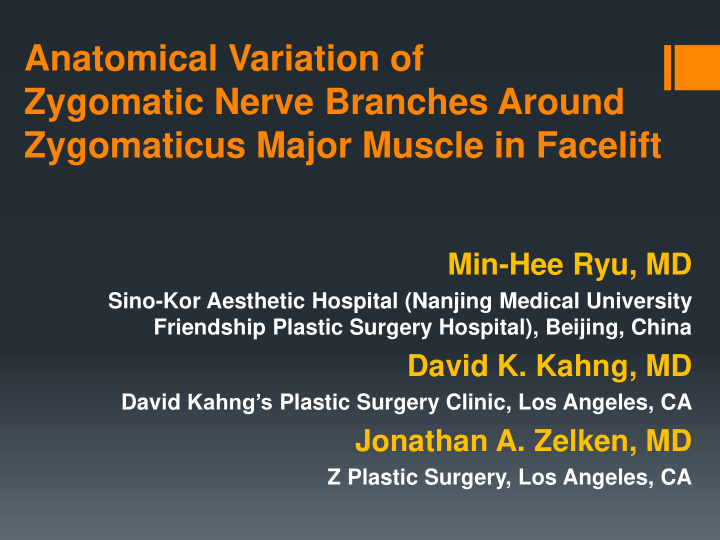



Anatomical Variation of Zygomatic Nerve Branches Around Zygomaticus Major Muscle in Facelift Min-Hee Ryu, MD Sino-Kor Aesthetic Hospital (Nanjing Medical University Friendship Plastic Surgery Hospital), Beijing, China David K. Kahng, MD David Kahng’s Plastic Surgery Clinic, Los Angeles, CA Jonathan A. Zelken, MD Z Plastic Surgery, Los Angeles, CA
Disclosure Nothing to disclose Plastic Surgery The Meeting 2016, Septemebr 23-27, 2016, Los Angeles Convention Center, Los Angeles, California
Objective To improve the mid-facial soft tissue sagging, it is sometimes necessary to release the zygomatic and upper masseteric retaining ligaments in the sub-SMAS plane. Release of these ligaments needs to be done carefully to avoid any injuries to the branches of the facial nerve.
Objective Some of the zygomatic branches run towards the Zygomaticus major muscle are located deep to the fascia and passes deep under the muscle. 1,2 third of the Zygomaticus major However, anatomical variation of the zygomatic branches were found. This is a case of the anatomic variation of the zygomatic branches seen unilaterally in a single patient undergoing facelift.
Materials and method A healthy 66 year old female patient underwent a facelift procedure.
Results After the zygomatic and upper masseteric retaining ligaments were released in the sub- SMAS plane, an anatomical variation of the zygomatic branches were identified lateral to the origin of the Zygomatic major muscle on the left side only. The branches penetrated from the deep fascia about 1 cm lateral to the origin of the zygomaticus major muscle; one ramus passed superficially above the upper third of the muscle. On the right side, this was not seen.
Results
Conclusions We should be aware of this unique case where the variation was only seen unilaterally. Particular care must be taken when dissection is performed to release the retaining ligaments. We hope this case can contribute to avoid nerve injuries in facelift procedures.
Significance of the findings The main zygomatic retaining ligaments are located immediately lateral to the origin of the zygomaticus major muscle. The zygomatic branches are usually located deep to the deep fascia in the lateral area of the muscle and passes deep under the third of the muscle. Therefore, the branches are protected while the retaining ligaments are dissected in the sub-SMAS plane.
Significance of the findings However, in this patient, the risk of the zygomatic branch injury is higher so blunt dissection, adequate vertical traction of the SMAS flap, and the use of tumescent solution are needed to visually differentiate between the retaining ligaments and the nerve branches to avoid any injury. 3
References 1. Alghoul M, Bitik O, McBride J, Zins JE. Relationship of the Zygomatic Facial Nerve to the Retaining Ligaments of the Face: The Sub-SMAS Danger Zone. Plast Reconstr Surg. 2013;131:245e. 2. Mendelson BC, Muzaffar AR, Adams WP Jr. Surgical Anatomy of the Midcheek and Malar Mounds. Plast Reconstr Surg. 2002;110:885 – 896; discussion 897 – 911. 3. Ryu MH, Moon VA. High Superficial Musculoaponeurotic System Facelift with Finger-assisted Facial Spaces Dissection for Asian patients. Aesthet Surg J. 2015;35;1-8.
Corresponding Author Dr. Min-Hee Ryu Chief Director Sino-Kor ( Beijing ) Medical Aesthetic Hospital (Nanjing Medical University Friendship Plastic Surgery Hospital) Add : NO. 109 Nongguangli, Chaoyang District,Beijing City, China 100021 Mobile : +82-10-6254-8672, +86-183-1138-3833 E-mail: psryuminhee@gmail.com
Recommend
More recommend